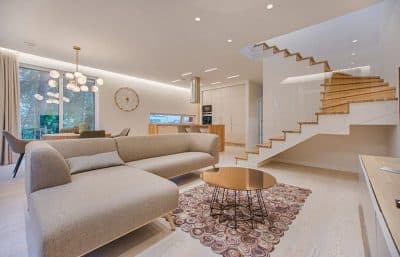
When it comes to styling a room, windows often take centre stage — and for good reason. They bring in natural light, offer views of the outdoors, and shape the atmosphere of any space. But figuring out what to place in front of them? That’s a design challenge many homeowners face.
Should you keep the space open and airy or make it functional with furniture that doesn’t block the view? The key is to find a balance between style and practicality. Whether you’re working with a large bay window, a bedroom window with morning light, or a compact space needing some personality, the right furniture can completely transform the look and feel of your room. For instance, adding a chaise lounge in Perth homes is one way to enhance these spaces, offering comfort, visual appeal, and versatility without overwhelming the natural light or views. Here’s how to make the most of that prime spot in front of your windows.
Before You Choose: A Few Things to Keep in Mind
Choosing furniture for your window space shouldn’t just be about filling a gap. The goal is to enhance the beauty of your room while maintaining function, comfort, and visual appeal.
Natural Light and Window Height
Before you add anything, evaluate how much light your windows bring in. Low, wide windows are ideal for longer furniture like benches or sideboards, while tall windows may call for a more vertical or delicate silhouette that doesn’t block the view or daylight. North-facing windows in Australia bring in softer light, perfect for lounging, while west-facing ones might make certain materials fade faster over time.
Room Function and Layout
Consider what the room is used for and how traffic flows through it. In a lounge room, seating in front of the window can create a relaxing retreat. In a bedroom, that space may serve as additional storage or a morning reading nook. And in entryways or halls, the area in front of a window is perfect for slender pieces like benches or a console table.
Also, think about sightlines. Can you still enjoy the garden view from across the room? Is the window a focal point or just a secondary feature?
Privacy and Ventilation
Do you rely on that window for airflow? Is it street-facing? These details should shape your choices. For windows that need to be opened regularly, avoid placing bulky items that are hard to move. If privacy is a concern, opt for furniture that works well with sheer curtains or offers subtle visual coverage, like a decorative screen or lower cabinet.
5 Furniture Pieces That Shine in Front of Windows
The right furniture can elevate your window area from unused space to a stylish feature. Here are five tried-and-true pieces that work beautifully in front of windows.
The Ultimate Lounge Spot: Add a Chaise By The Window
There’s something timeless about a chaise sofa. Elegant and inviting, a chaise is the perfect way to make use of window space in a lounge or bedroom. Not only does it provide a plush seat for reading, relaxing, or soaking in the sun, but it also adds a luxurious, sculptural touch to any room.
Look for low-profile designs that don’t cover too much of the glass. Linen fabrics and curved shapes help create a soft, organic flow that complements natural light.
Stylish and Practical: Benches That Do It All
Benches are one of the most versatile pieces you can use in front of a window. Whether upholstered or timber, they sit low enough not to interfere with views while offering versatile functionality.
- Use them in entryways as a perch to put on shoes.
- Add storage beneath for blankets or baskets.
- Pair them with a few scatter cushions for added comfort.
A well-placed bench can anchor a room visually while keeping the mood relaxed and casual.
Anchor the Room: Place a King or Queen Bed near the Window
When your bedroom layout calls for placing your bed near a window, both king and queen bed frames can create stunning focal points. A queen bed offers flexibility in smaller rooms, allowing more space around the window for styling, while a king bed makes a bold statement in larger bedrooms.
Position your bed so the headboard doesn’t block natural light, and consider low-profile frames that won’t compete with the window’s proportions. Upholstered headboards in neutral tones work beautifully with window light, creating a serene backdrop for rest and relaxation.
Make Your New Favourite Reading Nook: Try an Armchair
An armchair by the window is one of the simplest ways to define a space and give it purpose. Whether it’s for reading, scrolling, or enjoying your morning coffee, this setup turns a regular spot into a comforting ritual.
If you’re looking for armchairs, think about scale — oversized chairs may overpower a smaller window, while sleek, sculptural ones add character without clutter. Place a side table nearby to complete the nook and consider a floor lamp for nighttime use.
Keep It Sleek: Go For a Console or Sideboard
If storage is a top priority, go vertical with a console table or a sideboard that complements the window’s proportions. These pieces offer a practical surface for displaying vases, books, or candles without closing in the space.
Looking for a console table that fits seamlessly into your style? Choose one with clean lines and open legs to maintain that light-filled feeling. Alternatively, if you need more storage, buffets and sideboards are excellent choices, particularly in dining or open-plan areas where extra space for linens or crockery is always a bonus.
Design Tips to Get the Look Just Right
Choosing the right furniture is only the first step. A few clever styling techniques can help you tie the whole room together — and make your window zone feel intentional.
Keep It Low and Light
Avoid tall, bulky furniture that blocks too much light or interrupts the flow of the room. Go with pieces that complement, not compete with, your windows. Open-leg furniture helps maintain visual airiness, especially in smaller spaces.
Use Sheer Curtains or Blinds
Dress your windows in a way that adds texture without cutting off the light. Sheer curtains, roman blinds, or linen drapes allow you to soften the look and control privacy while still enjoying natural light during the day.
Maintain Symmetry and Balance
When placing furniture in front of a window, consider how it fits with the rest of the room. Symmetry helps achieve a cohesive look, especially if you’re using paired furniture like armchairs or lamps. Don’t let one side of the room feel heavier or more cluttered than the other.
Common Mistakes to Avoid
Even with the best intentions, it’s easy to make design missteps. Here are a few common mistakes to watch out for when styling furniture in front of your windows.
Blocking Too Much Light
Natural light is a valuable resource in any home, and it’s easy to lose it by placing bulky or tall furniture directly in front of a window. Avoid blocking more than one-third of the window if possible, and prioritise open or leggy designs that let the light pass through.
Forgetting About Function
A piece might look stunning in front of the window but become a pain if it interferes with opening the blinds, cleaning the glass, or accessing the window itself. Always make sure your choice works with how you use the space day-to-day.
Choosing Oversized Pieces
That gorgeous sectional might seem perfect until it’s pushed up against a window and suddenly the room feels smaller. It’s important to take measurements — not just of the furniture, but of the visual space it will occupy. Leave a little breathing room on either side for a more relaxed, intentional look.
Final Reflections
Windows are more than just sources of light, they’re powerful design tools that can set the mood, shape the flow of a room, and highlight your personal style. With a bit of thoughtful planning, you can turn that underutilised space in front of your windows into something both beautiful and functional.








